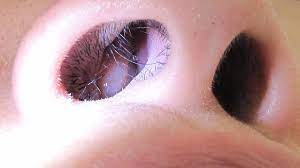



Introduction
Nasal polyps are hypertrophied oedematous mucosa of the nose and paranasal sinuses resulting in a pedunculated mass. This is not a new growth. It is composed of fibro-oedematous tissue and the surface is lined with ciliated columnar epithelium.
Types
1-Simple mucous polyps-Commonest variety.
2-Fungal polyps.
3- Neoplastic polyps.
But ordinarily by nasal polyps we mean simple mucous polyps.
SIMPLE MUCOUS POLYPS
Aetio-pathology
These polyps are end - product of prolonged oedema of the mucosa and submucosa of the nose and sinuses due to allergy. The submucosa around the middle meatus is lax and gets filled up with intracellular serous fluid and shows oedematous hypertrophy.The mucosal swelling is aggravated by the traction of the discharge , poor aeration of the middle meatus , efforts to clear the nose , and possible interference with lymphatic flow . The oedema blocks the ostium of ethmoidal air - cells and cause secondary bacterial infection. Gravity and narrowness of the meatus promote downward extension and formation of polyps.
Antro - choanal polyp arises from oedematous mucosa of the maxillary sinus near the ostium and grows by oedematous hypertrophy through the ostium into posterior part of the nasal cavity and nasopharynx. The ostium is directed backward. So part of the polyp is in the sinus and part in nose and nasopharynx.
Following aetiological factors are found
1- Allergy- Majority of the nasal polyps are initially allergic in origin. Eosinophil and plasma cells are found.
2- Vasomotor or Vascular phenomenon-similar to allergy, but no allergen found.
3- Infection- due to bacterial or viral infection.
4- Mixed- allergy and infection play part.
5- Concentration of immunoglobulin IgE in serum and eosinophil infiltration may play some part.
Types according to site of origin
1- Antro-choanal polyps- It arises from the maxillary antrum and extents backward to the posterior naris or choana.
2- Ethmoidal polyps- more common. They arise from the ethmoidal cells and grow towards the anterior nares.
Clinical features
1. Nasal obstruction is the chief symptom and is persistent. This is unilateral in antro - choanal and usually bilateral in ethmoidal polyps. Antro - choanal polyp may produce bilateral obstruction when it blocks both the choanal apertures. The obstruction by polyp sometimes becomes acute following a cold. Nasal intonation is often seen.
2. Sneezing and rhinorrhoca may be associate symptoms. Purulent rhinorrhoca may be present in ethmoidal polyps.
3. Headache is often a feature. Hawking and cough may be present due to post - nasal discharge.
4. Hyposmia and anosmia may also be present.
5. Ethmoidal polyps- are better seen on anterior rhinoscopy. There are multiple, bluish - white or greyish pedunculated mass, usually bilateral, coming from the ethmoidal area. There may be associated infection (pus) in the meati. Polyps, reaching anterior nares, may be pinkish in colour due to exposure and squamous metaplasia. Probe test shows soft, mobile, insensitive mass and differentiates from oedematous turbinates. In long standing cases there may be expansion or broadening of the external nose, known as ' frog - face ' due to large number of polypoid mass trying to come out through anterior nares.
6. Antrochoanal polyp- is better seen in posterior rhinoscopy, as a bluish - white smooth polypoid mass coming out of choanal aperture arising from middle meatus. It is unilateral. Sometime anterior part of the polyp can be seen on anterior rhinoscopy. In advanced case polyp may be seen hanging behind soft palate in the oropharynx.
TREATMENT AT DR. SOHAN LAL CLINIC
The integrated POLYCLINIC facility offers patients to select their treatment either from the Department of Homeopathy or from the Department of Medicine.
We provide scientific, research-based, and professional services to people across the world, aiming to achieve the highest success rate.
